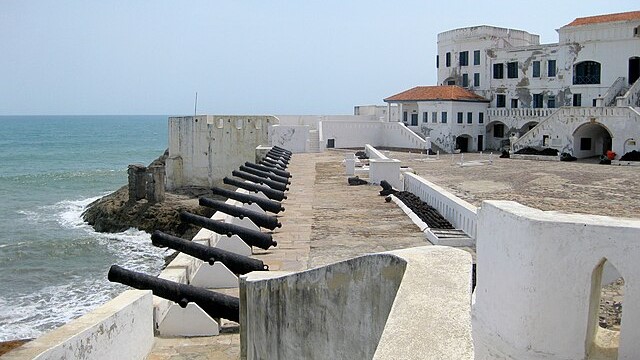Along Ghana’s southern shoreline, the Atlantic surf breaks against whitewashed stone walls that have stood for centuries. Cape Coast Castle, perched on the edge of the Gulf of Guinea, is one of West Africa’s most enduring monuments to both human suffering and resilience. Its thick walls and shadowed chambers tell a story at once intimate and global, echoing a past that shaped nations on both sides of the ocean.
Originally established in the mid-17th century by Swedish traders, the fortress shifted hands between European powers before becoming a key stronghold of the British during the transatlantic slave trade. From its subterranean dungeons, tens of thousands of Africans were forced onto ships bound for the Americas. The architecture itself bears the weight of this history: dank stone cells, cramped and airless, still carry the memory of those who were held within.
Guides who lead visitors through the complex recount histories that linger beyond the physical structure—oral traditions, archival accounts, and stories passed down by descendants of the enslaved. The narratives encompass more than statistics; they conjure images of lives interrupted and families torn apart, but also of resistance and endurance. In the upper courtyards, where European officers once lived, the view stretches over the Atlantic. The vista is serene, yet the horizon evokes a dual legacy: a waterway of commerce, but also a route of immense loss.
The castle’s role, however, is not confined solely to its association with enslavement. Today, it functions as both a memorial and a cultural archive. Exhibitions display Ghanaian textiles, carvings, and works of contemporary art, placing the brutality of the past in conversation with traditions that have survived and flourished. These presentations underscore the continuing vitality of Ghanaian culture, even as they acknowledge the traumas that sought to erase it.
For many, Cape Coast Castle stands as more than a preserved relic. It is a place of education and confrontation, where history is neither abstract nor distant. In its juxtaposition of suffering and beauty—the stark dungeons below and the glittering ocean beyond—the site forces a reckoning with the contradictions of human experience. The resilience of communities who endured, and who continue to carry forward their cultural heritage, remains perhaps the castle’s most powerful legacy.
Sources:
- Ghana Museums and Monuments Board, Cape Coast Castle (official site)
- Kwame Anthony Appiah, The Ethics of Identity, Princeton University Press, 2005
- National Museum of Ghana, archival records on the transatlantic slave trade

